Tree-SID + COE
Tree-SID + COE
Tree-SID has been discussed as a multicast technology in IOS-XR. Our goal is to enhance that technology and expand its potential thats why we are optimizing it by using Crosswork Optimization Engine (COE).
There are 2 major challenges that we are trying to overcome:
- The lack of accurate and intuitive visibility into multicast deployments
- The effective alignment with the controller architecture
To solve the above we need a tool to discover and visualize the multicast policies the controller holds. In our case we can leverage COE and achieve operational agility with ease of visualization while providing rich automation benefits with a controller friendly architecture.
Cisco Crosswork is a suite of integrated applications that deliver adaptive network operations to achieve an autonomous, cloud-scale infrastructure using software-defined tools to manage multi-vendor and multi-domain networks. Cisco Crosswork Optimization Engine provides real-time network visualization and optimization capabilities, allowing operators to maximize network utility and increase service velocity.
Today we want to showcase the integration of Static and Dynamic Tree-SID with COE. The Crosswork team has invested time and effort to evolve Tree-SID into an automated solution while providing enhanced user experience. We have the option to visualize Tree-SID topology, sessions, policies, and more in line with an automated Multicast solution. In the rest of this article, we will go over screenshots from the COE dashboard and use them to visualize the TreeSID SR Policies on the routers.
Furthermore, there is the need of validating tree disjointness for video distribution:
- SR-PCE allows to compute and deploy it (automatically).
- COE allows to visualize, and ‘prove’ trees are disjoint.
Topology
The topology that will be used is shown below.
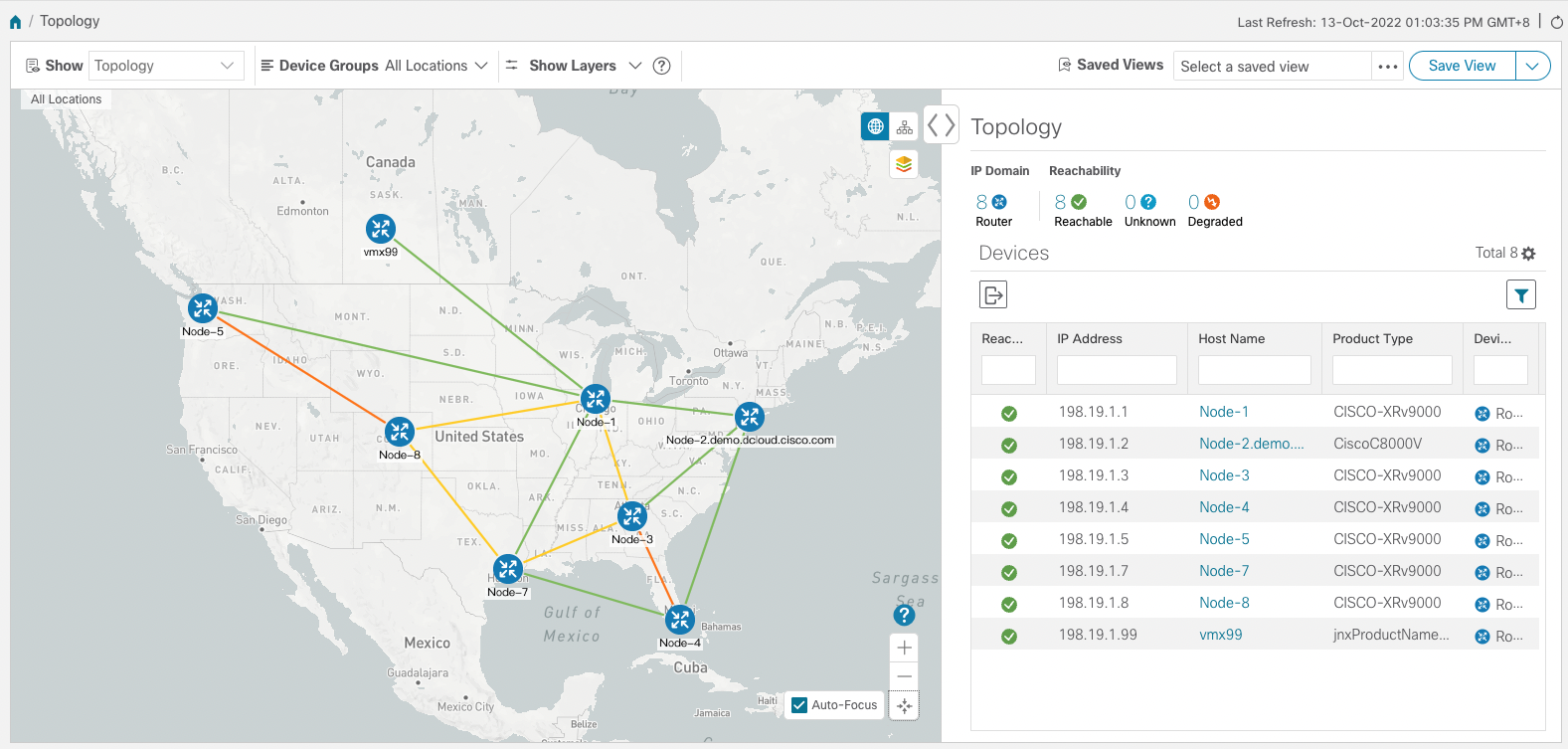
We can see all the nodes that will be used in the following examples. The nodes are xrv9k devices and they will be used for both Static and Dynamic Tree-SID.
Common Configuration
SR-PCE Configuration
The PCE holds PCEP sessions with all the routers in the topology. We can verify that by running the following command:
Command:
show pce ipv4 peer
Output:
PCE's peer database:
--------------------
Peer address: 198.19.1.1
State: Up
Capabilities: Stateful, Segment-Routing, Update, Instantiation, SRv6
Peer address: 198.19.1.3
State: Up
Capabilities: Stateful, Segment-Routing, Update, Instantiation, SRv6
Peer address: 198.19.1.4
State: Up
Capabilities: Stateful, Segment-Routing, Update, Instantiation, SRv6
Peer address: 198.19.1.5
State: Up
Capabilities: Stateful, Segment-Routing, Update, Instantiation, SRv6
Peer address: 198.19.1.7
State: Up
Capabilities: Stateful, Segment-Routing, Update, Instantiation, SRv6
Peer address: 198.19.1.8
State: Up
Capabilities: Stateful, Segment-Routing, Update, Instantiation, SRv6
Static Tree-SID + COE
In our topology, there are two static Tree-SID policies configured,
- sr_p2mp_root_198.19.1.5_static_c40
- sr_p2mp_root_198.19.1.5_static_c41
Both Tree-SID policies are rooted at Node-5 but are optimized for different metric (TE and IGP metric respectively). Tree-SID policies also support the use of link affinity constraints, although this is not configured in the current setup.
The following screenshots show one of the static Tree-SID polices as rendered by the Crosswork Optimization Engine. All essential information on the Tree-SID policy including the root node, name, tree-ID, admin and operational Status, SR label, type (static/dynamic), metric type, affinity constraints and path details are shown. This allows the operator to view all essential information pertaining to the Tree-SID policy at a glance.
Static Tree-SID policy summary:
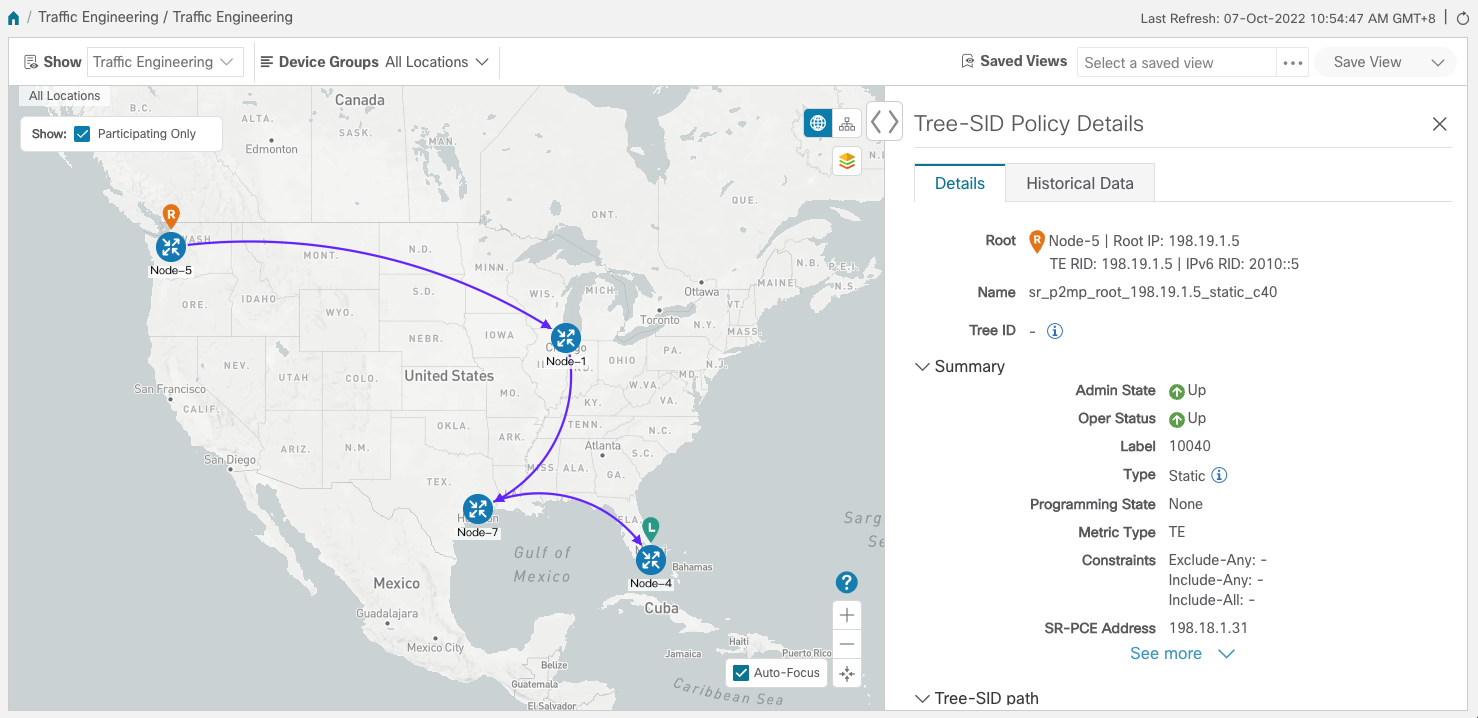
Static Tree-SID policy path:
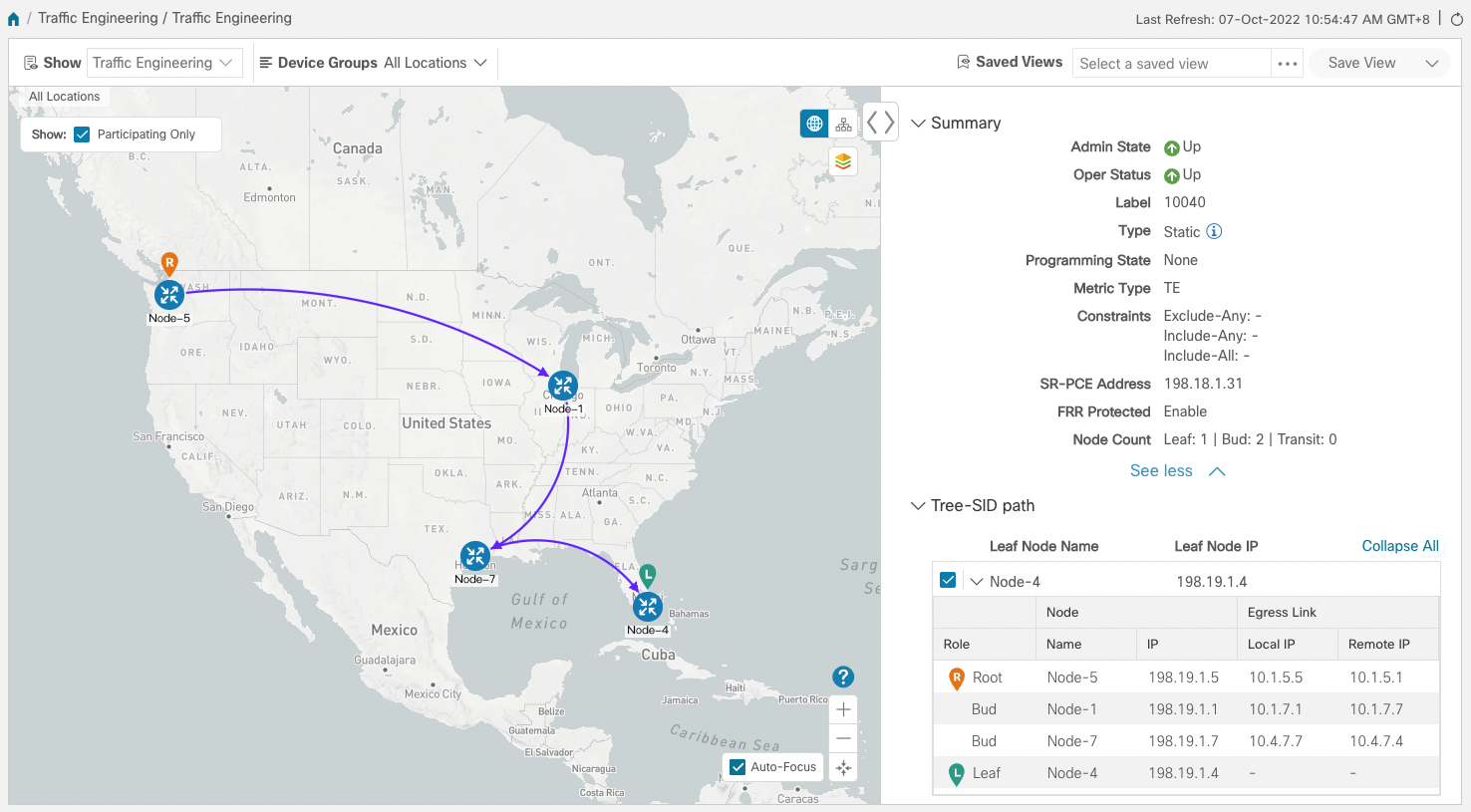
We can see from the path topology that the Tree-SID policy is rooted at Node-5. Bud nodes are Node-1, Node-7 and the Leaf node is Node-4.
In addition, COE maintains an event history of the Tree-SID policy. The operator may use the COE UI to learn about past events such as admin and operational state changes, and changes in the Tree-SID SR policy paths. When an event is selected, details of the Tree-SID Policy Path at that time will be shown.
Static Tree-SID policy events:
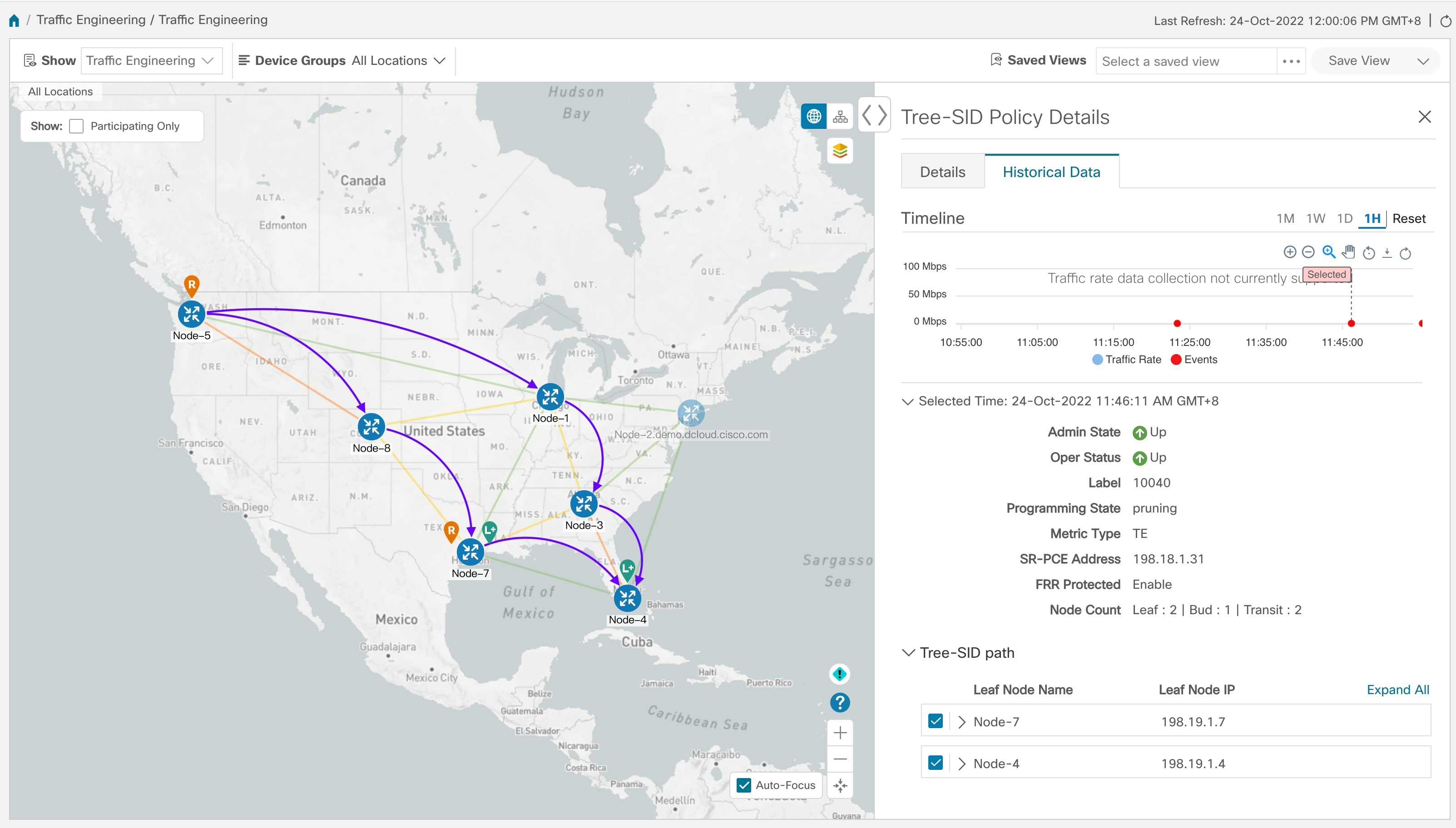
Note: For Static Tree-SID only the PCE configuration is required to initiate the Tree-SID Policy on the control plane. The rest of the configuration are provided for completeness.
Configurations
PCE config:
pce
address ipv4 198.19.1.201
segment-routing
traffic-eng
p2mp
endpoint-set sr_p2mp_c40_ep
ipv4 198.19.1.1
ipv4 198.19.1.4
ipv4 198.19.1.7
!
endpoint-set sr_p2mp_c41_ep
ipv4 198.19.1.1
ipv4 198.19.1.3
ipv4 198.19.1.4
!
policy sr_p2mp_root_198.19.1.5_static_c40
source ipv4 198.19.1.5
color 40 endpoint-set sr_p2mp_c40_ep
treesid mpls 10040
candidate-paths
preference 100
dynamic
metric
type te
!
policy sr_p2mp_root_198.19.1.5_static_c41
source ipv4 198.19.1.5
color 41 endpoint-set sr_p2mp_c41_ep
treesid mpls 10041
candidate-paths
preference 100
dynamic
metric
type igp
Root config:
vrf L3VPN_NM-SRTE-ODN-40
address-family ipv4 unicast
import route-target
65000:40
!
export route-target
65000:40
!
vrf L3VPN_NM-SRTE-ODN-41
address-family ipv4 unicast
import route-target
65000:41
!
export route-target
65000:41
!
!
!
interface Loopback40
description T-SDN interface
vrf L3VPN_NM-SRTE-ODN-40
ipv4 address 10.40.5.1 255.255.255.252
!
interface Loopback41
description T-SDN interface
vrf L3VPN_NM-SRTE-ODN-41
ipv4 address 10.41.5.1 255.255.255.252
!
route-policy sr-p2mp-core-tree
set core-tree sr-p2mp
end-policy
!
multicast-routing
address-family ipv4
interface Loopback0
enable
!
mdt source Loopback0
!
vrf L3VPN_NM-SRTE-ODN-40
address-family ipv4
mdt source Loopback0
interface all enable
mdt static segment-routing
!
vrf L3VPN_NM-SRTE-ODN-41
address-family ipv4
mdt source Loopback0
interface all enable
mdt static segment-routing
!
!
!
router pim
address-family ipv4
interface Loopback0
enable
!
!
vrf L3VPN_NM-SRTE-ODN-40
address-family ipv4
rpf topology route-policy sr-p2mp-core-tree
sr-p2mp-policy sr_p2mp_root_198.19.1.5_static_c40
static-group 232.0.0.40 10.40.5.1
!
!
!
vrf L3VPN_NM-SRTE-ODN-41
address-family ipv4
rpf topology route-policy sr-p2mp-core-tree
sr-p2mp-policy sr_p2mp_root_198.19.1.5_static_c41
static-group 232.0.0.41 10.41.5.1
Leaf config:
vrf L3VPN_NM-SRTE-ODN-40
address-family ipv4 unicast
import route-target
65000:40
!
export route-target
65000:40
!
vrf L3VPN_NM-SRTE-ODN-41
address-family ipv4 unicast
import route-target
65000:41
!
export route-target
65000:41
!
!
!
interface Loopback40
description T-SDN interface
vrf L3VPN_NM-SRTE-ODN-40
ipv4 address 10.40.4.1 255.255.255.252
!
interface Loopback41
description T-SDN interface
vrf L3VPN_NM-SRTE-ODN-41
ipv4 address 10.41.4.1 255.255.255.252
!
route-policy sr-p2mp-core-tree
set core-tree sr-p2mp
end-policy
!
multicast-routing
address-family ipv4
interface Loopback0
enable
!
mdt source Loopback0
!
vrf L3VPN_NM-SRTE-ODN-40
address-family ipv4
mdt source Loopback0
interface all enable
static sr-policy sr_p2mp_root_198.19.1.5_static_c40
mdt static segment-routing
!
!
vrf L3VPN_NM-SRTE-ODN-41
address-family ipv4
mdt source Loopback0
interface all enable
static sr-policy sr_p2mp_root_198.19.1.5_static_c41
mdt static segment-routing
!
!
!
router igmp
vrf L3VPN_NM-SRTE-ODN-40
interface Loopback40
join-group 232.0.0.40 10.40.5.1
!
!
vrf L3VPN_NM-SRTE-ODN-41
interface Loopback41
join-group 232.0.0.41 10.41.5.1
!
!
!
router pim
address-family ipv4
interface Loopback0
enable
!
!
vrf L3VPN_NM-SRTE-ODN-40
address-family ipv4
rpf topology route-policy sr-p2mp-core-tree
!
!
vrf L3VPN_NM-SRTE-ODN-41
address-family ipv4
rpf topology route-policy sr-p2mp-core-tree
!
!
Show Outputs
PCE
The control plane has already been established and we can see the LSPs that are rooted at Node-5, Root Node (198.19.1.5) with the corresponding Tree-IDs.
Command:
show pce lsp p2mp
Output:
Tree: sr_p2mp_root_198.19.1.5_static_c40, Root: 198.19.1.5
PCC: 198.19.1.5
Label: 10040 Operational: up Admin: up
Local LFA FRR: Enabled
Metric Type: TE
Transition count: 1
Uptime: 00:16:31 (since Fri Oct 07 02:36:42 UTC 2022)
Destinations: 198.19.1.1, 198.19.1.4, 198.19.1.7
Nodes:
Node[0]: 198.19.1.5 (Node-5)
Role: Ingress
Hops:
Incoming: 10040 CC-ID: 1
Outgoing: 10040 CC-ID: 1 (198.19.1.1!) [Node-1]
Node[1]: 198.19.1.1 (Node-1)
Role: Bud-Node
Hops:
Incoming: 10040 CC-ID: 2
Outgoing: 10040 CC-ID: 2 (198.19.1.7!) [Node-7]
Node[2]: 198.19.1.7 (Node-7)
Role: Bud-Node
Hops:
Incoming: 10040 CC-ID: 4
Outgoing: 10040 CC-ID: 4 (198.19.1.4!) [Node-4]
Node[3]: 198.19.1.4 (Node-4)
Role: Egress
Hops:
Incoming: 10040 CC-ID: 5
Root
Now lets check the configuration of that specific VRF (L3VPN_NM-SRTE-ODN-40). The multicast routing for IPv4 and the bgp auto-discovery are enabled and we will use mdt static segment routing.
Command:
show run multicast-routing vrf L3VPN_NM-SRTE-ODN-40
Output:
multicast-routing
vrf L3VPN_NM-SRTE-ODN-40
address-family ipv4
mdt source Loopback0
interface all enable
mdt static segment-routing
!
!
!
Dynamic Tree-SID + COE
The topology that will be used is shown below.
In our topology, there is a dynamic Tree-SID policy configured. The following shows a screenshot of the dynamic Tree-SID policy as rendered by the Crosswork Optimization Engine.
Dynamic Tree-SID policy summary:
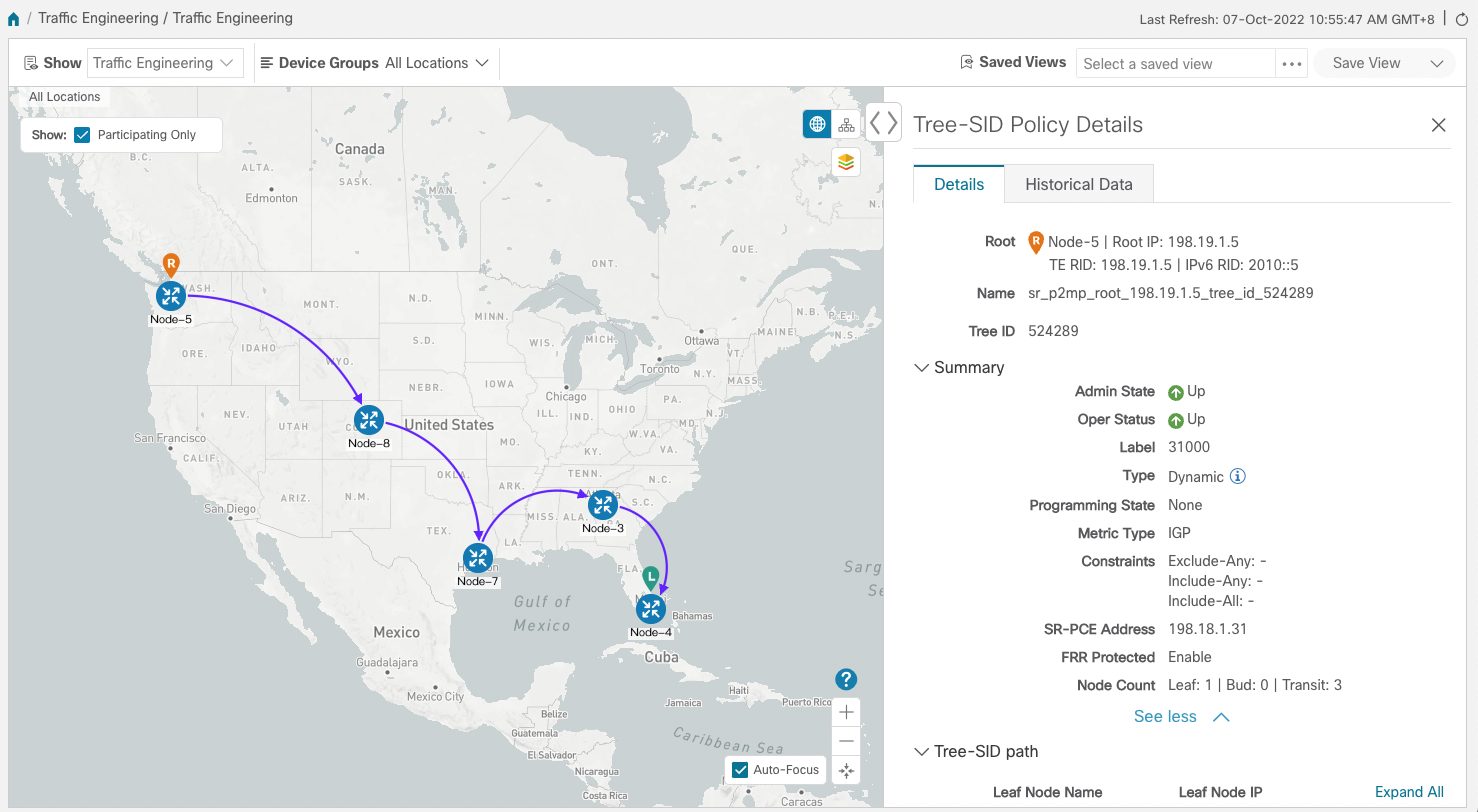
Dynamic Tree-SID policy path:
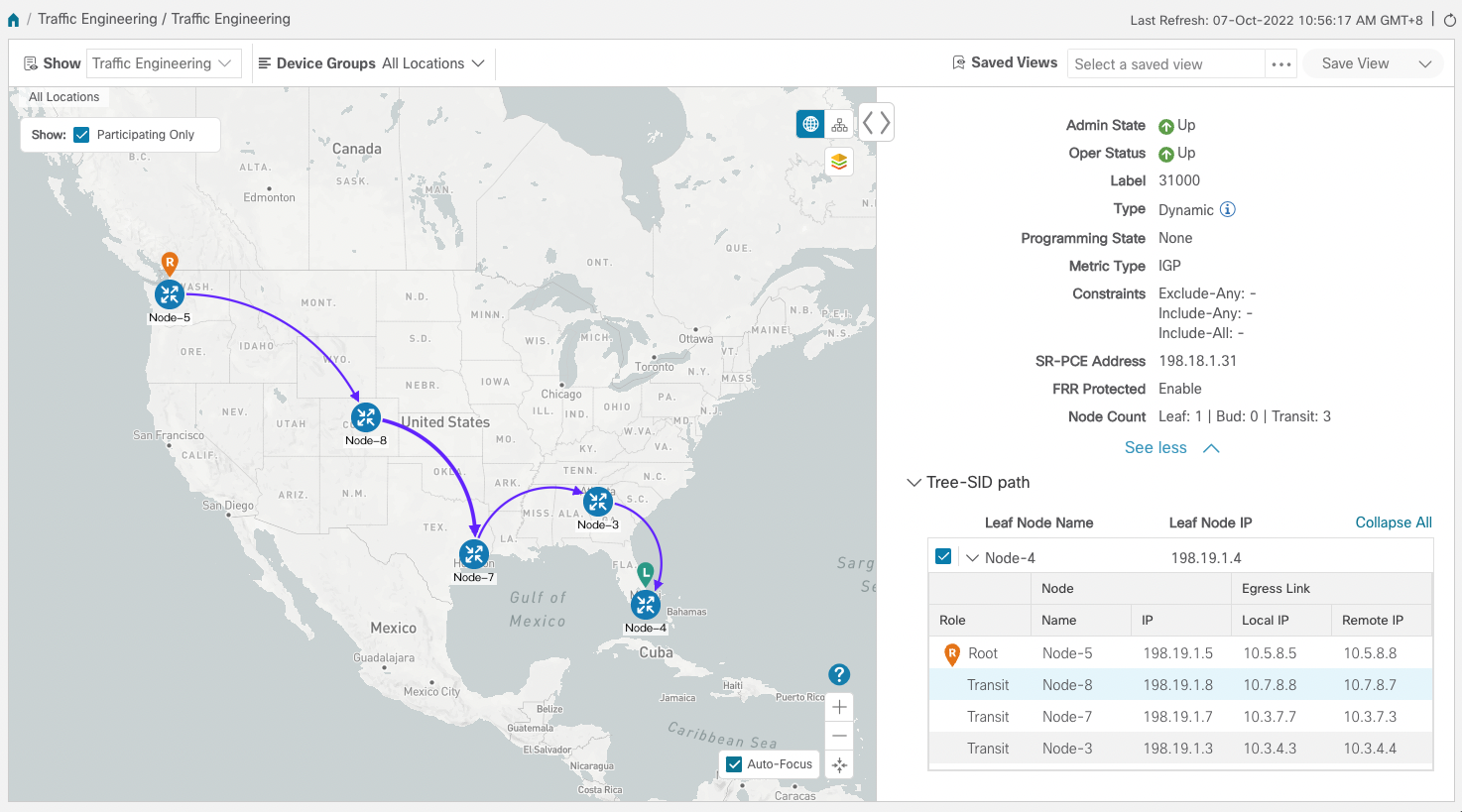
We can see from the path topology that the Root is Node-5, Transit nodes are Node-8, Node-7, Node-3 and the Leaf node is Node-4.
Note: SR Policy events history is currently not available for Dynamic Tree-SID policies.
Configurations
On the PCE, we require a label-range for allocation for Dynamic Tree-SID policies. The PCE will also allocate a dynamic Tree-ID value which is not present for static Tree SID policies.
PCE config
router bgp 65000
address-family ipv4 mvpn
!
neighbor-group AS65000-RRC-services-group
address-family ipv4 mvpn
route-reflector-client
!
pce
segment-routing
traffic-eng
p2mp
label-range min 30000 max 31000
fast-reroute lfa
multipath-disable
Root config
vrf L3VPN_NM-MVPN-80
address-family ipv4 unicast
import route-target
65000:80
!
export route-target
65000:80
!
!
router bgp 65000
address-family ipv4 mvpn
!
neighbor-group RR-services-group
address-family ipv4 mvpn
!
vrf L3VPN_NM-MVPN-80
rd 65000:80
address-family ipv4 unicast
redistribute connected
!
address-family ipv4 mvpn
!
!
segment-routing
traffic-eng
on-demand color 80
dynamic
pcep
!
metric
type igp
!
route-policy L3VPN_NM-MVPN-80
if destination in (232.0.0.80) then
set on-demand-color 80
pass
endif
end-policy
!
interface Loopback80
description T-SDN interface
vrf L3VPN_NM-MVPN-80
ipv4 address 10.80.5.1 255.255.255.252
!
multicast-routing
vrf L3VPN_NM-MVPN-80
address-family ipv4
interface all enable
bgp auto-discovery segment-routing
!
mdt default segment-routing mpls color 80
mdt data segment-routing mpls 2 color 80
!
!
Leaf config
vrf L3VPN_NM-MVPN-80
address-family ipv4 unicast
import route-target
65000:80
!
export route-target
65000:80
!
!
!
router bgp 65000
address-family ipv4 mvpn
!
neighbor-group RR-services-group
address-family ipv4 mvpn
!
vrf L3VPN_NM-MVPN-80
rd 65000:80
address-family ipv4 unicast
redistribute connected
!
address-family ipv4 mvpn
!
!
!
interface Loopback80
description T-SDN interface
vrf L3VPN_NM-MVPN-80
ipv4 address 10.80.4.1 255.255.255.252
!
multicast-routing
vrf L3VPN_NM-MVPN-80
address-family ipv4
interface all enable
bgp auto-discovery segment-routing
!
mdt default segment-routing mpls color 80
!
!
The transit nodes do not hold any Tree-SID specific configuration.
Show outputs
PCE
Command:
show pce lsp p2mp root ipv4 198.19.1.5 | include Tree
Output:
Tree: sr_p2mp_root_198.19.1.5_tree_id_524289, Root: 198.19.1.5 ID: 524289
The next output shows the Tree stucture including the Root (Ingress), the Transit nodes and the leaves (Egress) with the corresponding label ID (31000) of the Tree. The PCE will pick a label within the provided range to be allocated for the dynamic Tree-SID policy. For Dynamic Tree-SID policies, a dynamic Tree-ID value will be allocated by the SR-PCE.
Command:
show pce lsp p2mp root ipv4 198.19.1.5
Output:
Tree: sr_p2mp_root_198.19.1.5_tree_id_524289, Root: 198.19.1.5 ID: 524289
PCC: 198.19.1.5
Label: 31000 Operational: up Admin: up
Local LFA FRR: Enabled
Metric Type: IGP
Transition count: 1
Uptime: 06:10:10 (since Mon Oct 03 02:06:06 UTC 2022)
Destinations: 198.19.1.4
Nodes:
Node[0]: 198.19.1.3 (Node-3)
Role: Transit
Hops:
Incoming: 31000 CC-ID: 1
Outgoing: 31000 CC-ID: 1 (198.19.1.4!) [Node-4]
Node[1]: 198.19.1.7 (Node-7)
Role: Transit
Hops:
Incoming: 31000 CC-ID: 2
Outgoing: 31000 CC-ID: 2 (198.19.1.3!) [Node-3]
Node[2]: 198.19.1.8 (Node-8)
Role: Transit
Hops:
Incoming: 31000 CC-ID: 3
Outgoing: 31000 CC-ID: 3 (198.19.1.7!) [Node-7]
Node[3]: 198.19.1.5 (Node-5)
Role: Ingress
Hops:
Incoming: 31000 CC-ID: 4
Outgoing: 31000 CC-ID: 4 (198.19.1.8!) [Node-8]
Node[4]: 198.19.1.4 (Node-4)
Role: Egress
Hops:
Incoming: 31000 CC-ID: 5
Root
From the root node we can get information such as VRFs, traffic-eng configurations, mvpn and segment-routing configurations.
Command:
show vrf L3VPN_NM-MVPN-80
Output:
VRF RD RT AFI SAFI
L3VPN_NM-MVPN-80 65000:80
import 65000:80 IPV4 Unicast
export 65000:80 IPV4 Unicast
Now lets check the configuration of that specific VRF. The multicast routing for IPv4 and the bgp auto-discovery are enabled, we will use segment routing P2MP and we will allow default MDT based on P2MP SR policy.
Command:
show run multicast-routing vrf L3VPN_NM-MVPN-80
Output:
multicast-routing
vrf L3VPN_NM-MVPN-80
address-family ipv4
interface all enable
bgp auto-discovery segment-routing
!
mdt default segment-routing mpls color 80
mdt data segment-routing mpls 2 color 80
!
!
!
There is one important thing to notice in the following command output which is the metric type IGP. Any Tree that is going to be built as part of the default or data MDT is going to be built based on that metric.
Command:
show run segment-routing traffic-eng on-demand color 80
Output:
segment-routing
traffic-eng
on-demand color 80
dynamic
pcep
!
metric
type igp
!
!
!
!
!
Below we can see the Route Type 1s for the PEs. Node-5 (198.19.1.5) is the Ingress PE and Node-4 (198.19.1.4) is the Egress PE.
Command:
show bgp vrf L3VPN_NM-MVPN-80 ipv4 mvpn
Output:
BGP VRF L3VPN_NM-MVPN-80, state: Active
BGP Route Distinguisher: 65000:80
VRF ID: 0x60000003
BGP router identifier 198.19.1.5, local AS number 65000
Non-stop routing is enabled
BGP table state: Active
Table ID: 0x0 RD version: 5
BGP main routing table version 5
BGP NSR Initial initsync version 2 (Reached)
BGP NSR/ISSU Sync-Group versions 0/0
Status codes: s suppressed, d damped, h history, * valid, > best
i - internal, r RIB-failure, S stale, N Nexthop-discard
Origin codes: i - IGP, e - EGP, ? - incomplete
Network Next Hop Metric LocPrf Weight Path
Route Distinguisher: 65000:80 (default for vrf L3VPN_NM-MVPN-80)
*>i[1][198.19.1.4]/40 198.19.1.4 100 0 i
*> [1][198.19.1.5]/40 0.0.0.0 0 i
Processed 2 prefixes, 2 paths
The following is the default MDT or I-PMSI. It has 1 member which is root Node-4 (198.19.1.4) and there is a Tree with ID 524289.
Command:
show mvpn vrf L3VPN_NM-MVPN-80 database segment-routing
Output:
* - LFA protected MDT
Core Type Core Tree Core State On-demand
Source Information Color
Default 198.19.1.5 524289 (0x80001) Up 80
I-PMSI Leg: 198.19.1.4
Part 0.0.0.0 0 (0x00000) Down 80
Control 0.0.0.0 0 (0x00000) Down 80
Transit Node 3
Below we can see the P2MP SR policy on all transit nodes that are part of the Tree-SID topology.
Command:
show segment-routing traffic-eng p2mp policy root ipv4 198.19.1.5
Output:
SR-TE P2MP policy database:
----------------------
! - Replications with Fast Re-route, * - Stale dynamic policies/endpoints
Policy: sr_p2mp_root_198.19.1.5_tree_id_524289 LSM-ID: 0x40002
Root: 198.19.1.5, ID: 524289
Role: Transit
Replication:
Incoming label: 31000 CC-ID: 1
Interface: None [198.19.1.4!] Outgoing label: 31000 CC-ID: 1
Transit Node 7
Command:
show segment-routing traffic-eng p2mp policy root ipv4 198.19.1.5
Output:
SR-TE P2MP policy database:
----------------------
! - Replications with Fast Re-route, * - Stale dynamic policies/endpoints
Policy: sr_p2mp_root_198.19.1.5_tree_id_524289 LSM-ID: 0x40003
Root: 198.19.1.5, ID: 524289
Role: Transit
Replication:
Incoming label: 31000 CC-ID: 2
Interface: None [198.19.1.3!] Outgoing label: 31000 CC-ID: 2
Transit Node 8
Command:
show segment-routing traffic-eng p2mp policy root ipv4 198.19.1.5
Output:
SR-TE P2MP policy database:
----------------------
! - Replications with Fast Re-route, * - Stale dynamic policies/endpoints
Policy: sr_p2mp_root_198.19.1.5_tree_id_524289 LSM-ID: 0x40003
Root: 198.19.1.5, ID: 524289
Role: Transit
Replication:
Incoming label: 31000 CC-ID: 3
Interface: None [198.19.1.7!] Outgoing label: 31000 CC-ID: 3
This concludes the configuration and show command outputs from the IOS-XR devices, as well as showcasing Crosswork Optimization Engine’s Tree-SID visualization capabilities. We hope you find this article informative.
Leave a Comment